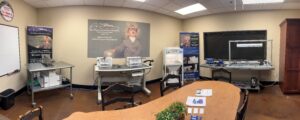
Static Control Meets Source Capture: The PCS Clean Table Advantage
PCS Clean Table: Source Capture and Static Control for Contamination‑Free Packaging If you’re routinely cleaning trays, medical packaging or delicate parts prior
Effective contamination control is crucial in medical device manufacturing, particularly due to the impact of electrostatic fields on plastic parts and cleanroom operations. Low static fields, such as 2,000 volts, can attract particulate matter, compromising cleanroom effectiveness. To counter this, the goal is to eliminate static charges.
Simco-Ion, Technology Group’s solutions include Benchtop and Overhead Ionizing Blowers, Ionizing Air Guns, and full-coverage Room Ionization Systems.
Once static is mitigated, addressing existing particles is important. Traditional ionizing air guns can blow off particles but may relocate them within the cleanroom. C.C. Steven’s Particle Capture System (PCS) captures particles at the source, offering various configurations allowing customized solutions to maintain cleanliness and prevent contamination.
Using these tools, static fields can be reduced to below 2,000 volts, eliminating the ability of parts to attract contaminants.
Several regulations and standards address static control in medical device manufacturing to ensure product safety and reliability.

PCS Clean Table: Source Capture and Static Control for Contamination‑Free Packaging If you’re routinely cleaning trays, medical packaging or delicate parts prior

Clean Cube: Proven Particle Capture, Demonstrated by Dr. Static At C.C. Steven & Associates, we know controlling particulate and static is essential for anyone

What Every Manufacturer Needs to Know About Static Control By Dr. Static (Stephen Carfaro), President of C.C. Steven & Associates Static

Why STATIC CONTROL Matters in Medical Device Manufacturing Environments WHERE DO ALL THE PARTICLES GO! Cleanroom & Particle Contamination Control

Why STATIC CONTROL Matters in Medical Device Manufacturing Environments Effective contamination control is crucial in medical device manufacturing, particularly

See What’s New in Our Expanded Demo Room – Where Innovation Meets Real-World Solutions We’re excited to unveil our new